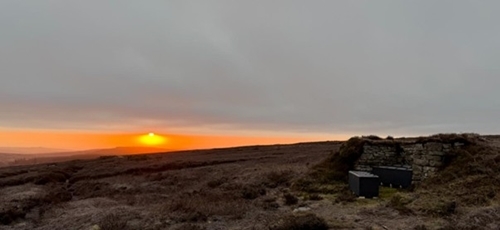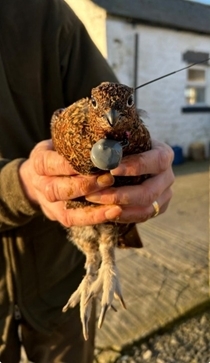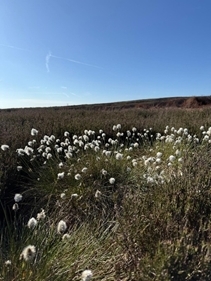Written by Leah Cloonan and Sam Rawlinson
In the spring of this year the Upland Research Team in northern England returned to a project that previously ran in 2022 and 2023. The project looks at the maternal condition of red grouse and which factors affect their subsequent breeding success. Red grouse tend to breed quite well, however, after poor breeding years in 2021and 2024, we were eager to pick this project up again.

This year we have been following the breeding outcomes of 48 red grouse hens from four sites in the North Pennines. The study sites form an altitudinal gradient and cover a range of different habitats - dry heath and blanket bog, overlying deep peat and shallow peat.
The fieldwork kicked off in March with spring pair grouse counts to determine pre-breeding densities on the study sites. During the same time, and with invaluable help from the gamekeepers on the study sites, we caught 12 hens on each of the four areas at night. Biometric and body condition measurements were recorded for each hen then they were then placed in a holding box overnight, so that we could collect their caecal samples early the next morning. We conducted caecal egg counts on these samples to determine their pre-breeding parasite burdens, particularly those of strongyle worms, which are known to have a large impact on red grouse health and productivity. These data can then be related back to their body condition scores. Soon after the birds had been tagged, we searched the sites for fresh caecal pats so we could establish the worm burden of the study site as a whole as well as that of the individual birds.
Hens were fitted with a necklace radio (VHF) tag before being released near their site of capture soon after dawn. Each tracker transmits sound at a unique frequency which allow us to identify, locate and track individuals. Tracking these hens keeps us busy through March and April. By mapping where they are found we can get a good idea of their territory size.

It’s not just body condition and parasite burdens that may affect grouse breeding productivity. Their habitat and food sources can also play a role. To investigate the role of these, the vegetation at each site is also monitored. For six weeks starting in March, prior to nesting, we take heather samples every week, the main food source of red grouse. This will be analysed to assess its nutritional value and whether this changes over the sampling period. We have also monitored the emergence and abundance of cottongrass flower heads, an important alternative food source. This data will give us an insight into the quality of the food available for the hens at a crucial time, just before they start to lay and incubate their eggs.

In the last week of April we start to locate nests. Once we locate a nest, we note the clutch size, measure the eggs and insert a small temperature data logger into the nest lining. This data logger will give us invaluable data into how many times the hen comes off of her nest to feed, and an accurate indication of date of nest failure or hatch date. Once hatched, we note the number of hatched eggs, and we start invertebrate sampling in a typical brood foraging area to assess chick food availability in the seven days following hatching. The availability of craneflies is important for the survival of young grouse chicks in the early days, but it is not the only factor which influences the survival of young chicks. This year we have introduced a new element to the study which is the capture of rainfall data on a site by site basis. Damp ground is important for the emergence of key invertebrate species, but too much rainfall can have a detrimental effect on the survival of chicks.

We conduct brood counts twice for each hen, when the chicks reach two-weeks and seven-weeks old to monitor chick survival as they transition from an invertebrate rich diet to largely vegetation based diet, and to assess mortality from other causes. July brood counts are also then conducted on the same pre-planned transects as the March spring pair counts which provides us the number and size of broods as an indicator of breeding productivity for each site.
To round off the fieldwork for the season, we survey the vegetation structure and composition at the nest site and along four fixed transects, centred around the nest, within each hen’s territory. This allows us to identify habitat features which may affect breeding success, such as how well hidden a nest is, distance to significant habitat features such as stone walls, and location of nearest grit station. Once the shooting season begins, we conduct larder visits to take gut samples from a random selection of 20 old grouse from the study sites. Additionally, any shot hens with a VHF collar also get returned to us, so we can repeat the biometric measures which were taken in March (weight, wing length, body condition score) and all gut samples are analysed to estimate parasite burdens, again, giving us an idea of the site-level parasite loads.
Combined with the previous years’ data, all of the information we collect over the course of the project will give us more of an insight into some of the current drivers of red grouse breeding success and how this will guide future, modern, sustainable grouse moor management and conservation in the face of climate change, poor breeding years and increasing legislation. Next year we hope to expand the project, subject to funding, to the Scottish Borders and north east Scotland. This will allow us to see whether the factors affecting grouse productivity in the North Pennines are the same as those elsewhere in the country, or whether the challenges faced by breeding grouse and their chicks vary from region to region.
July 2025
With many thanks to Phil Warren for fitting radio-collars and conducting grouse counts.